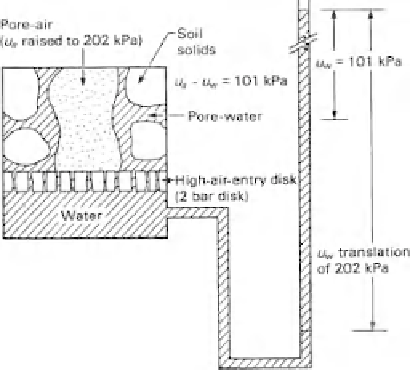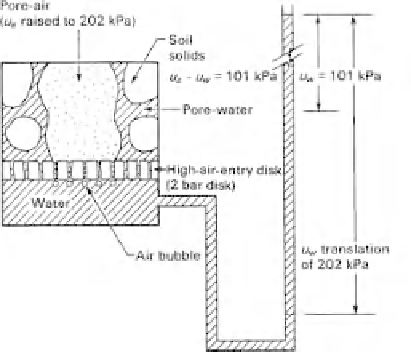Environmental Engineering Reference
In-Depth Information
and down until there is no tendency for flow in or out of
the specimen. The negative pressure head at equilibrium will
indicate the matric suction in the soil specimen (Fig. 11.26a).
However, this direct measurement of suction has limitations.
The porous disk in contact with the soil must have an
air-entry value greater than the matric suction in the soil.
The air-entry value of a porous disk is the matric suction
at which air commences passing through the largest voids
in the saturated porous disk. Air enters the water compart-
ment once the pressure differential between the air and water
phases exceeds the air-entry value of the ceramic disk. Con-
sequently, the water in the measuring system can no longer
indicate the pore-water pressure in the soil. The measuring
system then becomes filled with air.
Another limitation associated with attempting to directly
measure the pore-water pressure arises from the fact that
water cavitates as a gauge pressure of -1 atm is approached
(i.e., -101 kPa gauge). As an example, consider an unsatu-
rated soil specimen with a matric suction of 101 kPa. The
pore-water pressure in the specimen is being measured rel-
ative to atmospheric air pressure (i.e.,
u
a
=
(a)
0), as shown in
Fig. 11.26b. The lowest gauge pore-water pressure that can
be measured should be about -101 kPa. A saturated ceramic
disk with an air-entry value of 202 kPa would meet the
requirement for not allowing air flow through the ceramic
disk. Nevertheless, the water in the compartment below the
ceramic disk would start to cavitate as the gauge water pres-
sure approaches -101 kPa. Occluded air bubbles would then
start to accumulate below the disk in the water compartment.
The air bubbles would cause an error in the measurement of
pore-water pressure. The direct measurement of pore-water
pressure is limited to a value of -101 kPa. The limiting
value for the direct measurement of pore-water pressure is
true regardless of the air-entry value of the ceramic disk.
The limitations of direct control or measurement of pore-
water pressure in an unsaturated soil can be overcome by
translating the reference axis for the measurement of air
pressure. The procedure is referred to as the axis transla-
tion technique. The axis translation technique is particularly
useful for testing unsaturated soils at high matric suctions.
Basically, both the pore-air and pore-water pressures are
translated into the positive-pressure range when applying
the axis translation technique.
The translation of pore-air pressure can be considered
as an artificial increase in the atmospheric pressure under
which the test is performed (Bishop et al., 1960). Conse-
quently, the negative-gauge pore-water pressure is raised by
an equal amount to a positive-gauge pressure. The matric
suction of the soil specimen remains constant regardless of
the magnitude of the pore-air pressure. A fine, porous disk
with an air-entry value greater than the matric suction of
the soil must be used to prevent air from entering the water
compartment.
The application of an axis translation of 202 kPa to an
unsaturated soil specimen is illustrated in Fig. 11.27. Let
(b)
Figure 11.27
Measurement of pore-water pressure in an unsatu-
rated soil specimen using axis translation technique (not to scale):
(a) axis translation of 101 kPa; (b) air diffusion through high-air-
entry disk.
us assume that the matric suction in the soil specimen is
known to be 101 kPa. The pore-water pressure is measured
below a saturated porous disk which has an air-entry value of
202 kPa. An air pressure of 202 kPa is applied directly to the
specimen in order to translate the pore-air (and pore-water)
pressures. In this example, the pore-air pressure
u
a
is raised
to 202 kPa, which in turn increases the pore-water pressure
by an equal amount. As a result, the pore-water pressure
u
w
is now at a positive value of 101 kPa, and there is no
longer a problem associated with cavitation of the water in
the measuring system. The pore-water pressure can now be
measured since continuity is maintained between the pore-
water in the soil and the water in the measuring system. The
matric suction of the soil (Fig. 11.27a) remains constant at
101 kPa during the axis translation procedure. However, the
pore-air pressure which is used as a reference pressure has
been translated from 0 to 202 kPa.











Search WWH ::

Custom Search